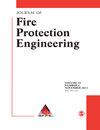Representing evacuation behavior in engineering terms
引用次数: 17
Abstract
In performance-based analyses, engineers evaluate whether a building design and/or evacuation procedure allows occupants sufficient time to evacuate before fire conditions become untenable. Guidance exists for the calculation of the time until conditions become untenable in areas of the structure (known as the available safe egress time) during fire situations. This article presents a method for determining the amount of time required for building occupants to reach a defined point of safety (known as the required safe egress time) for a particular building design or scenario. The method requires the engineer to identify real-world factors from the building conditions/situations that influence human performance (e.g. evacuation), understand the nature of their impact on human performance and then represent this impact in terms that can be employed within evacuation model calculations. An example is also presented to demonstrate the method described here.用工程术语表示疏散行为
在基于性能的分析中,工程师评估建筑设计和/或疏散程序是否允许居住者在火灾条件变得无法维持之前有足够的时间撤离。存在用于计算在火灾情况下,直到结构区域的条件变得无法维持的时间(称为可用安全出口时间)的指导。本文介绍了一种方法,用于确定特定建筑设计或场景中建筑物居住者到达指定安全点所需的时间(称为所需安全出口时间)。该方法要求工程师从建筑条件/情况中识别影响人类行为的真实因素(例如疏散),了解它们对人类行为影响的本质,然后用可用于疏散模型计算的术语表示这种影响。文中还给出了一个示例来演示本文所描述的方法。
本文章由计算机程序翻译,如有差异,请以英文原文为准。
求助全文
约1分钟内获得全文
求助全文

 求助内容:
求助内容: 应助结果提醒方式:
应助结果提醒方式:


